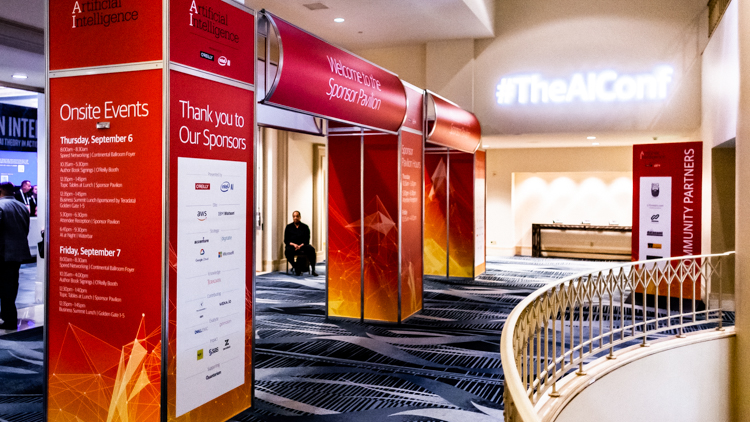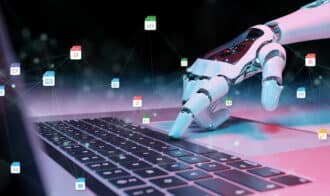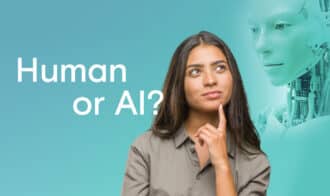- Have we reached peak human? The impact of AI on the workforce
- Moving AI off your product roadmap and into your products
- Empathic design for AI: The future is feeling
Have we reached peak human? The impact of AI on the workforce
 Mehdi Miremadi, partner at McKinsey & Company, described a global workforce in the context of AI automation. He notes that while a significant number of millenials are on the verge of adding to the global workforce, many baby boomers are simultaneously preparing for retirement. Mehdi postulates that growth in labor will halt in the next 50 years. To sustain healthy economic growth, worker productivity will need to increase at an appropriate rate.
Mehdi Miremadi, partner at McKinsey & Company, described a global workforce in the context of AI automation. He notes that while a significant number of millenials are on the verge of adding to the global workforce, many baby boomers are simultaneously preparing for retirement. Mehdi postulates that growth in labor will halt in the next 50 years. To sustain healthy economic growth, worker productivity will need to increase at an appropriate rate.
One of the key questions that we have is: what contribution, if any, could AI and automation have to [the challenge of increasing worker productivity]. Ultimately this will impact so many different aspects of our lives, both in the developed economies and in the developing countries. —Mehdi Miremadi, Partner McKinsey & CompanyMiremadi approached the topic of a global AI workforce from both a macro and a micro level. At the macro level, his team of McKinsey analysts identified entire industries and professions which would be directly affected by AI technology. To understand the impact of automation from a micro level, the team looked at specific case studies from the labor force. In the report, Miremadi categorized specific job tasks based on their potential for automation. For example, the analysts measured usage of digital tools such as email versus usage of physical tools such as landscaping shovels. Insights from the study revealed that about half the tasks workers are paid to perform are technically automatable today with existing technology. The key message is that automation will likely impact the vast majority of existing jobs. However, McKinsey found no correlation between compensation levels and the potential for task automation. The future of job automation is much more nuanced than the anecdotes we often hear.
We found that about 25% of what CEOs do is technically automatable using current technology, while only 9% of what landscaping workers do is automatable. —Mehdi Miremadi, Partner McKinsey & CompanyAutomation is not just about saving costs—it’s also about emotional considerations like safety, quality, and speed. With this in mind, the research suggests between 75 million and 375 million workers will see their profession changed by artificial intelligence in the next 15-20 years. These changes will lead to massive job creation in occupations that value technical skills and social sensitivity. In conclusion, artificial intelligence and automation will have a greater impact on the global workforce than any other technological revolution of the past, including the steam engine, the internet, and the IT revolution of the 1990s. Companies can safeguard the future of their businesses by investing now in machine learning and artificial intelligence.
Moving AI off your product roadmap and into your products
 Chief Data Officer Ashok Srivastava discussed how Intuit’s data science team is structured to deliver seamless and delightful user experiences. He also spoke about the value of implementing AI in technology-based services. In a successful product, AI, ML, and data come together to enable people to live their lives for the better. Proper integration of AI, ML, and structured data in the user experience helps companies maximize efficiency and revenue, all while delivering more relevant and meaningful customer experiences.
Chief Data Officer Ashok Srivastava discussed how Intuit’s data science team is structured to deliver seamless and delightful user experiences. He also spoke about the value of implementing AI in technology-based services. In a successful product, AI, ML, and data come together to enable people to live their lives for the better. Proper integration of AI, ML, and structured data in the user experience helps companies maximize efficiency and revenue, all while delivering more relevant and meaningful customer experiences.
If you have tens of millions of people working on your platform, you need to make sure that if you introduce AI or machine learning into the mix … the people are getting a seamless and delightful experience. —Ashok Srivastava, Chief Data Officer IntuitSrivastava noted the challenges most businesses face when implementing AI solutions: complexity, weak business cases, lack of budget, talent shortages, and missing and disparate data. In these situations, he recommends educating your team to become AI-ready. This education requires attention to technology, people, and data. When it comes specifically to data scientists, training your team to think from a product-design perspective is crucial to improving the user experience. One strategy for empowering your AI and ML team includes approaching ideas from multiple perspectives. In daily meetings, encourage the team to share broad thoughts. Broad thoughts can then be narrowed down in structured discussions. You can identify a good idea by the designer’s ability to articulate why that idea actually works to benefit the customer. Thoughtful articulation in the development stage correlates with a product’s approachability in the customer’s decision stage. Machine learning and artificial intelligence teams have an important role to play in the future of any business. With rapid prototyping and effective A/B testing, scaling AI in your products becomes an exciting project to tackle. Structuring your data for high-quality results is critical for creating a seamless and delightful user experience.
Empathic design for AI: The future is feeling
 Danielle Krettek is the founder of Google’s Empathy Lab, an interdisciplinary team that blends the social sciences with the creative arts. With projects in user research, product design, and film, the lab works to develop deep humanity in deep-learning products.
Danielle Krettek is the founder of Google’s Empathy Lab, an interdisciplinary team that blends the social sciences with the creative arts. With projects in user research, product design, and film, the lab works to develop deep humanity in deep-learning products.
What makes us the most human is to share and learn through the eyes of another. —Danielle Krettek, Founder Google Empathy LabThe Google Empathy Lab advocates for responsible design in artificial intelligence. By drawing on research about human behavior, Krettek’s team is creating the heart and soul of AI. While many designers are quick to consider the technical brain behind deep learning, it is a machine’s humanness that will return the most profound results. In a future where AI brings up new safety and ethical concerns, taking an empathetic approach to design will help engineers build more inclusive, human-centered technology.
We think of empathy as being that like deep human catharsis with your bestie, and that’s… not [it]. Really the deeper connection of empathy is you saying “that thing that you’re feeling? I know that feeling; I have been there. Me too.” —Danielle Krettek, Founder Google Empathy LabSmart assistants like Google Home and Apple’s Siri help us understand why humans value connected experiences. In a poorly designed product, the user’s curiosity becomes frustration, and that frustration becomes apathy. There’s a difference between speaking to your cellphone as a “he” or “she” versus as an “it.” When humans connect with AI products in a meaningful way, technologists can understand how to build a more human future. In a more human future, human nature is prioritized over machine insensitivity and empathy wins over apathy. Empathic design is not just about diversity and inclusion; it’s about designing for the long-term sustainability of organic intelligence—it’s about the future of “team human.”
People ask: Is empathy possible for machines? And for me, right now, based on what I know now, no. But I think what is possible is an empathic leap—which is—you can see through another’s eyes and connect to a feeling that you wouldn’t have connected to before; that is absolutely possible… —Danielle Krettek, Founder Google Empathy LabKrettek analyzes the unique communication techniques that humans use to express emotion. In addition to word-based language, color and sound have played a significant role in the research at The Google Empathy Lab. She references renowned scientists Carl Sagan and Ann Druyan for their work on The Golden Record which was sent into space as a representation of humanity through photography and music. She also notes film director Steven Spielberg’s contribution to the lab’s studies. In his films, Close Encounters of the Third Kind and ET, Spielberg’s attention to music and light help us imagine humanness in the context of futuristic life. While the movie characters were unable to communicate using spoken language alone, sound and color served as the essential facilitator for an empathic relationship between human beings and extraterrestrials. Advancements in AI hold untold potential for improving the way humans communicate and connect with other beings. Whether that be with the plants and animals on planet Earth, with futuristic aliens in outer space, or with the smart assistants in our cellphones, human-powered product development is imperative for protecting the future of “team human” with artificial intelligence and machine learning.
We need people who feel their feelings. And really—if you’re a caring human—that’s the most important qualification we have for people in AI right now. —Danielle Krettek, Founder Google Empathy Lab
 The O’Reilly Artificial Intelligence Conference is an important gathering for the AI community. With insights from the sessions we attended and the attendees we connected with, Appen’s team is committed to providing product managers, engineers, and business leaders—anyone developing a machine learning initiative—with high-quality training data with a human touch.
—
Are you interested in staying up to date on the latest trends in artificial intelligence and machine learning? Follow us on Youtube for video updates on industry news. Contact us to learn more about human-annotated data solutions for machine learning and artificial intelligence.
The O’Reilly Artificial Intelligence Conference is an important gathering for the AI community. With insights from the sessions we attended and the attendees we connected with, Appen’s team is committed to providing product managers, engineers, and business leaders—anyone developing a machine learning initiative—with high-quality training data with a human touch.
—
Are you interested in staying up to date on the latest trends in artificial intelligence and machine learning? Follow us on Youtube for video updates on industry news. Contact us to learn more about human-annotated data solutions for machine learning and artificial intelligence. 










